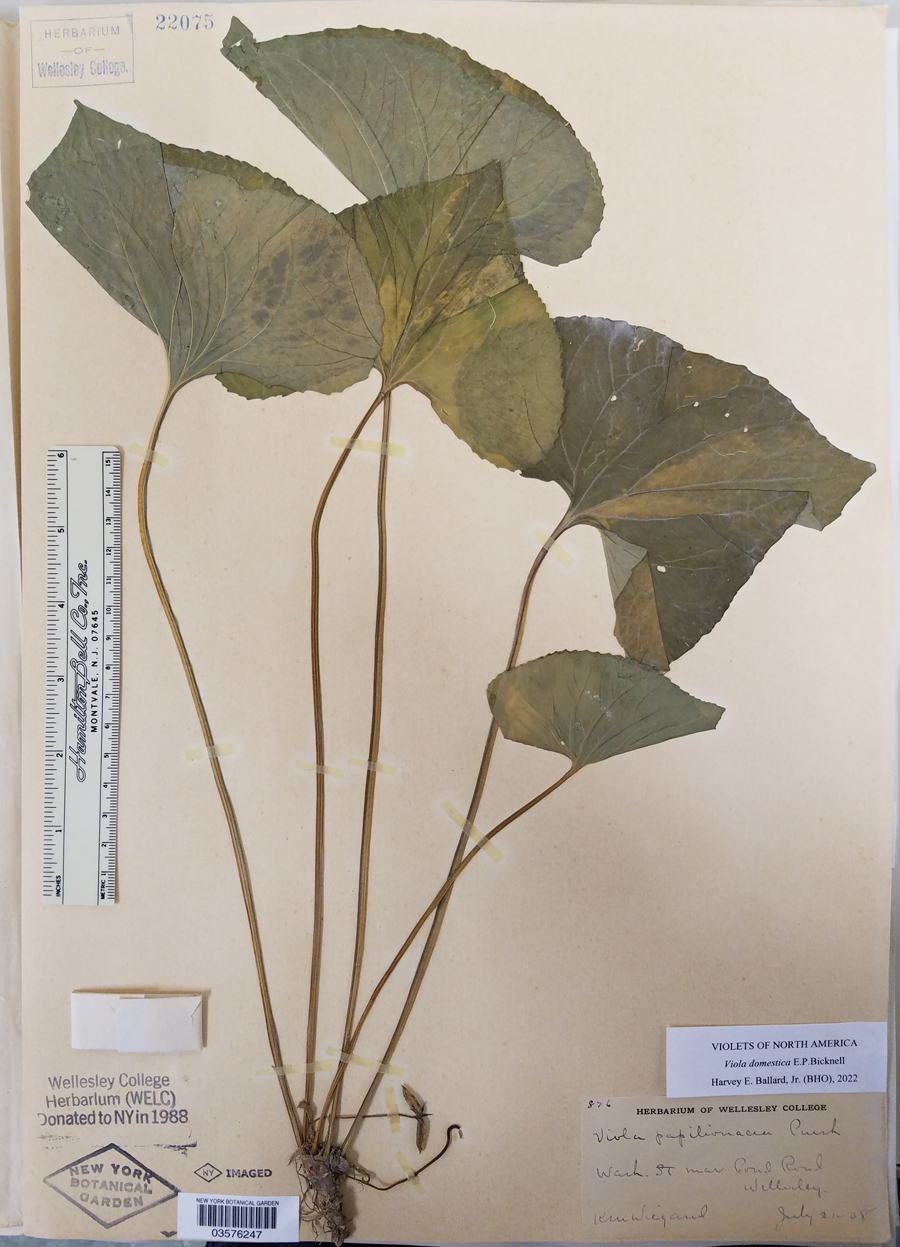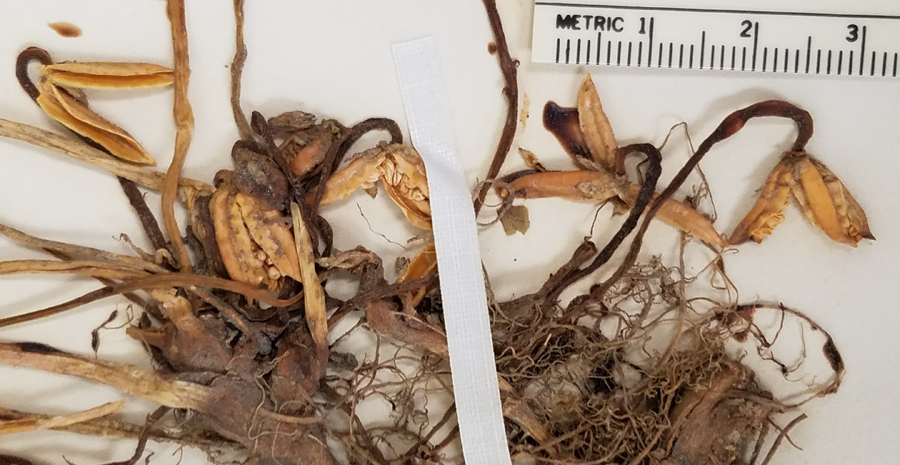Viola domestica E.P.Bicknell
Common names:
Yard Violet
Synonyms:
Viola domestica E.P. Bicknell, Britton & Brown, Illust. Fl. US & Canada 3 [Appendix]: 519. 1898; Viola papilionacea Pursh var. domestica (E.P.Bicknell) Pollard, in Britton, Man. fl. n. states, ed. 1: 636. 1901. Type: U.S.A. New York. [New York Co.] Fort Washington, 7 Aug 1897, E.P. Bicknell s.n. (lectotype (designated by Ballard et al. 2020. Journal of the Botanical Research Institute of Texas 14(2): 220.): NY00097529, internet image).
Description:
Acaulescent rosulate perennials from thick rhizome, ≤ 38 cm tall; foliage and peduncles light to medium green, dull (occasionally the upper surface of leaf blades slightly glossy), glabrous; stipules free, irregularly glandular-fimbriate; leaves ascending, leaf blades undivided, largest ≤ 126 × 90 mm, in spring broadly ovate to deltate-ovate, in summer broadening to deltate-reniform and often reaching very large size, base cordate to shallowly cordate but in summer nearly or quite truncate and shortly cuneate-decurrent to the summit of the petiole, margins conspicuously incurved-crenate-serrate to the abruptly obtuse-angulate apex, eciliate; chasmogamous peduncles held among the leaves; chasmogamous flower ≤ 18 mm; calyx eciliate; lowest sepals oblong-lanceolate, convexly tapering to acute apex; auricles slightly prominent, quadrate, weakly elongating in fruit to 1.5 mm; corolla blue to purple, throat white; spur short-globose; lateral petals densely bearded with filiform to slightly clavate hairs, spurred petal glabrous; cleistogamous flowers produced after chasmogamous, on short arching to ascending peduncle much shorter than petioles; cleistogamous capsule 11–14 mm, green drying tan, unspotted, glabrous; seeds **–** × **–** mm, **.
Similar species:
Among Borealiamericanae taxa with strictly or essentially glabrous foliage and leaf blades as broad as or broader than long (including some V. cucullata), V. domestica differs from V. nephrophylla in its glabrous spurred petal, sepals with acute apices and prominent auricles; and from V. cucullata, V. domestica, V. sororia [glabrous variant] and V. sororia [hirsutuloides variant] in its deep green orbicular to deltate-reniform leaf blades with upper surface glossy and glabrous or with minute appressed hairs (visible with magnification), and margins closely and uniformly crenate, ovate-triangular sepals acuminate from the middle, and prominent auricles. In cleistogamous fruit, it can be separated from V. affinis and V. missouriensis in its often unspotted cleistogamous capsule on gradually erect-sinuous peduncle, ovate-triangular acuminate eciliate sepals, weakly elongating auricles, and blackish unspotted or minutely spotted seeds. It is distinguished from V. langloisii, V. pratincola and V. retusa in its its glossy orbicular to deltate-reniform leaf blades with apex obtuse to rounded, margins closely and uniformly crenate, and shorter and broader ovate-triangular sepals acuminate from the middle rather than from the base. In chasmogamous flower, the Confederate Violet, V. communis f. priceana, is distinct from wholly albino floral forms found rarely in many Borealiamericanae taxa in having a white corolla with the nectarguides dense, coalescing and forming a nearly complete contrasting blue-gray to purple eyespot around the throat. Aside from albino floral forms, it could only be confused with Viola cucullata, as they both have a similar floral color pattern and also a glabrous spurred petal and prominent auricles. The Confederate Violet differs from Viola cucullata in the flowers scarcely or not overtopping the leaves (except where constantly mowed), ovate-triangular sepals acuminate from the middle, and long often tangled lateral petal beards with narrowly linear to very slightly clavate hairs that obscure the throat of the corolla. Forma priceana is identical in other respects with f. communis and in fruit is distinguished as noted above for the species.
Ecology:
Found only in relatively rich loamy soils in garden plantings and other actively disturbed sites.
Distribution:
Still incomplete, sporadic over the eastern U.S.
Rarity:
None
Phenology:
Uncertain, but likely similar to V. communis.
Affinities:
This species belongs to the Acaulescent Blue Violet lineage, sect. Nosphinium W.Becker, subsect. Boreali-Americanae (W.Becker) Gil-ad, in the Cucullata species group.
Hybrids:
None yet confirmed, although occasional plants with sparsely hirsute foliage may reflect hybridization; this bears investigation.
Comments:
Bicknell published the name in the Appendix to Britton and Brown's (1898) "Illustrated Flora" and provided a broad geographic range and habitat, stating that it was “Apparently always in cultivated soil, especially about buildings, southern New York, New Jersey and Pennsylvania.” Bicknell designated no types and cited no herbaria. According to Stafleu and Cowan (1976), Bicknell’s herbarium and types are at NY. The NY00097529 sheet constitutes original material. McKinney annotated this sheet incorrectly as a holotype, but in his 1992 publication he designated a different sheet (USA, New York, Manhattan Island, 11 Jun 1993, T. Maring s. n., NY) that does not appear to be original material. Sheet NY00097529 is representative of the taxon based on Bicknell’s description and was selected by Ballard et al. (2020) as the lectotype.
After a few references to the name earlier in the last century, this violet has since been ignored or synonymized under the name Viola sororia Willd., which recently has been treated in a very broad sense. However, the morphological features of leaves, chasmogamous flowers, cleistogamous capsules, and seeds are not similar to either of the glabrous variants of V. sororia, being much closer to other members of the Cucullata species group, especially V. communis and V. pratincola. Many of its morphological features appear to be somewhat intermediate between or shared by either V. communis and V. sororia, and this taxon is almost undoubtedly a cultigen of plant breeders, perhaps descending from hybrids between both of those species but more similar to V. communis. It seems virtually confined to heavily cultivated sites, seeming scarcely to escape from where it was planted and only then to other nearby plantings or actively disturbed microsites.
Literature Cited:
Ballard Jr., H. E., R. N. Burwell, and S. L. Lockhart. 2020. Violaceae: Typifications and clarifications of names. In Weakley, A. S., D. B. Poindexter, H. C. Medford, B. A. Sorrie, C. A. McCormick, E. L. Bridges, S. L. Orzell, K. A. Bradley, H. E. Ballard, Jr., R. N. Burwell, S. L. Lockhart, and A. R. Franck. Studies in the vascular flora of the southeastern United States. VI. Journal of the Botanical Research Institute of Texas 14(2): 217-229.

Cleistogamous fruiting habit from herbarium specimen: MA, Wellesley, 21 July 1908, K. M. Wiegand 876 (NY03576247)

Leaves from herbarium specimen: MA, Martha's Vineyard, 10 Oct 1911, E. P. Bicknell 6178 (NY04298243)

Cleistogamous fruit from herbarium specimen: MA, Martha's Vineyard, 10 Oct 1911, E. P. Bicknell 6178 (NY04298243)

Map by Biota of North America Program